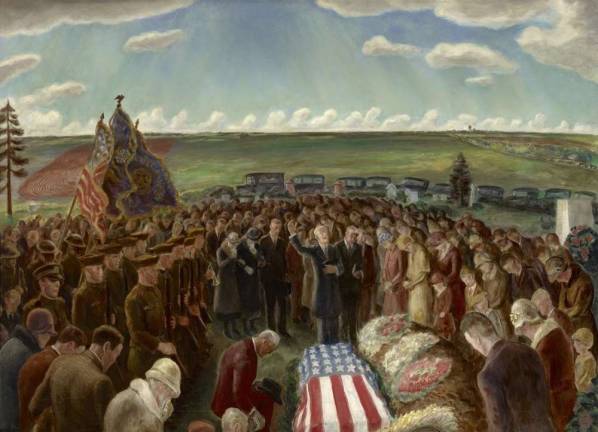hellfire and homecomings








BY VAL CASTRONOVO
The city’s commemoration of the 100th anniversary of the United States’ entry into World War I continues this spring with the opening of a somber show at the New-York Historical Society, “World War I Beyond the Trenches.”
Featuring more than 55 works culled from a recent exhibit at the Pennsylvania Academy of the Fine Arts, plus posters and artifacts from the museum’s collection, the show examines American artists’ responses to the war “over there” and its ramifications at home.
World War I was the first real high-tech war, waged with tanks, airplanes, machine guns and poison gas. Artists bore witness to the appalling carnage — some first-hand, most from a distance — and recorded their impressions in a variety of styles, in the moment and over time.
American expat painter John Singer Sargent, who served briefly as a field artist in 1918, was commissioned by the British War Memorials Committee to create a work for a Hall of Remembrance. His monumental tableau “Gassed” (1919), on loan from the Imperial War Museums in London, makes its New York debut at the Historical Society and is the show’s grim emotional center.
Recalling Bruegel’s “The Blind Leading the Blind” (1568) and the famous biblical proverb (Matthew 15:14), the canvas depicts a line of British soldiers with bandaged eyes staggering toward a dressing station at Le Bac-de-Sud after a mustard gas attack.
They trudge across wooden planking, flanked by piles of gassed comrades in the foreground, while life goes on in the background, where off-duty troops play soccer. As art historian David Lubin writes in the catalog, “World War I and American Art,” the work “implicitly criticizes the war — that is, the handling of the war by ‘blind’ politicians and generals.”
Generally speaking, Sargent’s presentation of the hostilities tends to be more sanguine — and indirect. Most of the watercolors on display emphasize the mundane aspects of a soldier’s life, with the ugliness of war suggested but not addressed head-on. Wounded men in a medical tent read newspapers and sleep; Scottish soldiers lounge outside a bombed building.
Some of the most powerful works are the creations of servicemen who were wounded in the war and used art to document the experience but also to heal. Horace Pippin was an African-American soldier who served in the Harlem Hellfighters (369th Infantry), a segregated unit. He was shot during the Meuse-Argonne offensive and suffered partial paralysis in his right arm.
More than a decade later, he began “The End of War: Starting Home” (1930-33), a thickly painted narrative work in which German soldiers in gray uniforms are seen surrendering to black troops in dark-brown uniforms that blend into the landscape. As Lubin writes: “Perhaps the relative ‘invisibility’ of the black soldiers ... had something to do, in the artist’s mind, with their relative invisibility in American culture at large ...”
Pippin made the frame, which is dotted with the tools of war — miniature grenades, tanks and rifles. As guest curator Robin Jaffee Frank explained on a recent tour, “It’s similar to African-American storytelling quilts, which show the tools of everyday life. Here the tools tell the story of war.”
Claggett Wilson was another wounded warrior who used art to tell war stories. A Marine who was gassed at the Battle of Belleau Wood in 1918, he created a series of graphic watercolors chronicling war wounds — men caught on barbed wire, falling from bullets and agonizing over lost limbs.
His “Flower of Death — The Bursting of a Heavy Shell — Not as It Looks, but as It Feels and Sounds and Smells” (c. 1919) is an abstract rendering of an explosion, with fire and flying cinders engulfing the landscape as two traumatized soldiers are caught in the crossfire.
But most artists experienced the war at a safe remove. Georgia O’Keeffe was inspired by her brother’s enlistment to paint “The Flag” (1918). A red-white-and-blue watercolor with a red flag partially subsumed by a wild blue sky, it suggests anxiety and ambivalence. Socialists and anarchists displayed red flags at meetings during the war, scholar Anne Classen Knutson notes in the catalog, and some states outlawed their display.
As Knutson writes about O’Keeffe’s provocative image, “[T]here is a friction between the two primary colors: is the patriotic blue obliterating the potentially subversive red, or is the red holding strong?”
George Bellows weighed in with a more definite view. Initially a pacifist, he was swayed by the 1915 Bryce Report detailing alleged German atrocities in occupied Belgium (most, but not all of it, true) to support American intervention. In “The Germans Arrive” (1918), German troops are shown savaging civilians. A townsman’s hands have been sliced off by a soldier’s long, bloody knife; another soldier has grabbed a woman by the neck.
Bellows’ violent imagery is tempered by Childe Hassam’s Impressionistic flag paintings, Jane Peterson’s soothing watercolor of women rolling bandages for the Red Cross, John Steuart Curry’s mournful scene of the belated burial of a friend’s remains and George Benjamin Luks’ riotous depiction of an Armistice celebration on the night of November 11, 1918.
Through Sept. 3.